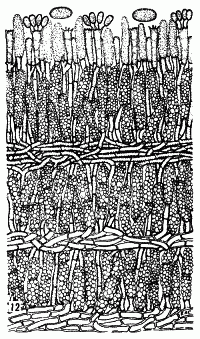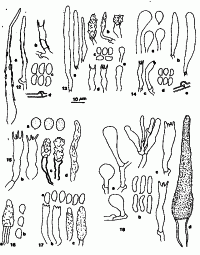|
 Phlebia totara Phlebia totara
SynonymsPeniophora totara
BiostatusPresent in region - Indigenous. Endemic
Images (click to enlarge)
Caption: Fig. 12. Peniophora totara G.H.Cunn. Transverse section, x 500. Spores, x 1000. | 
Caption: Fig. 12-18 , Fig. 12 Peniophora nikau [=Subulicystidium nikau] (PDD 13816), a: cystidia,
b: basidium, c: spores,.d:
basal hypha. Fig. 13 Peniophora verecunda [=Palifer verecundus](PDD 12513), a: leptocystidia, b: encrusted
cystidia, |
Article: Cunningham, G.H. (1955). Thelephoraceae of New Zealand. Part VI. The genus Peniophora. Transactions of the Royal Society of New Zealand 83(2): 247-293.
Description: Hymenophore perennial, cretaceous, adnate though tending to lift with the bark when dry,
effused forming irregularly linear areas to 28 x 5 cm, or sometimes numerous irregularly
elliptical colonies 1-3 x 1-2 cm; surface cream, staining ochre in patches, even, at length
scantily, somewhat areolately, creviced; margin thinning out, sometimes abrupt and cliff-like,
concolorous, adnate, compact. Context white, 0.2-1 mm thick, composed of numerous layers
each 35-55 µ deep, basal layer narrow, of compacted partly gelatinized parallel hyphae,
intermediate layer of mainly vertical hyphae and irregular rows of cystidia; generative hyphae
3.5-4 µ diameter, wall 0.2 µ thick, hyaline, naked, branched, septate, with clamp connexions.
Hymenial layer to 40 µ deep, a close palisade of basidia, paraphyses and cystidia. Basidia
subclavate, projecting, 16-22 x 5-6 µ, 4-spored; sterigmata slender, to 6 µ long. Paraphyses
subclavate, 14-16 x 4-5 µ. Cystidia cylindrical with apices rounded or bluntly acuminate,
sometimes narrowly conical, arranged in dense rows in the context and hymenium, 16-34 x 7-9 µ,
coarsely crystal coated, tending to disappear from the base. Spores elliptical, apiculate, 7-8 x 4-4.5 µ, walls smooth, hyaline, 0.2 µ
thick.
Habitat: HABITAT. Effused on bark of dead branches and trunks.
Distribution: DISTRIBUTION. New Zealand.
Notes: Specific features are the perennial thick context with stratose, cylindrical cystidia arranged in
zones separated from one another by parallel bands of partly gelatinized hyphae, and small
elliptical spores. Cystidia are small, crystal coated throughout, often arranged somewhat
irregularly, and tend to disappear from basal layers of thick specimens, leaving lacunae in the
tissues. Spores are scantily developed and tend to collapse soon after reaching maturity.
In its perennial stratose fructifications, masses of cystidia and small spores, the species
resembles P. crustosa. The latter may be separated by the brown zones of the context, formed
from granules of mucilage arranged in parallel bands. P. totara appears to be confined to two
species of Podocarpus, the Maori name for both being totara, hence the specific name.
Article: Stalpers, J.A.; Buchanan, P.K. (1991). Type studies of the species of Pellicularia and Peniophora described by G.H. Cunningham. New Zealand Journal of Botany 29(3): 331-340 (http://www.rsnz.org/publish/abstracts.php).
Description: Hyphae hyaline, thin- to slightly thick-walled, 2-4 µm wide, clamped at all septa. Cystidia thickwalled,
encrusted, 20-45 x 5-8.5 µm, when naked up to 5 µm wide. Basidia cylindrical, 20-35 x 5-6.5 µm. Spores
ellipsoid to cylindrical, smoothwalled, not amyloid, 7-9 x 3.5-4 µm.
Notes: The type material is in poor condition, with hyphal characters obscure and spores absent. Other PDD
collections also were found to be sterile. Two fresh collections on Podocarpus hallii made at the type
locality (PDD 48759, 48760) provided the basis for the above description of hyphal septation and spores.
The species was well described by Cunningham (1955, 1963), although cystidia did not appear to be
arranged in rows. The species belongs to Phlebia Fr. because of its waxy consistency when fresh,
clamped hyphae, ellipsoid spores, and narrowly clavate basidia. PDD collections were annotated by H.H.
Burdsall as Phlebia totara but this combination was not published (Burdsall, pers. comm.).
|